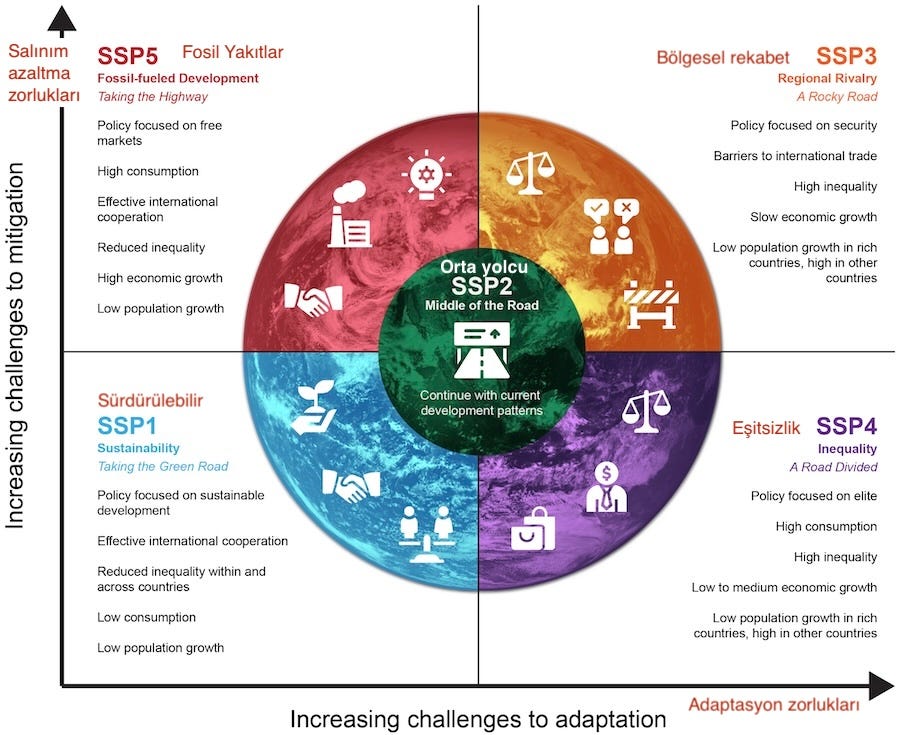"ROGUE Age" & Climate Change: Unpredictable Global Transitions
The world coming out of its fifty-year slumber is entering an 'interesting' new age. Two independent phenomena conflate with this process: Population implosion and Climate Change.
Please subscribe; please share. This blog will always be free.
There is one invariant in all Middle Eastern conflicts. Innocents die.
-+-+-+-+
The global transition into the "ROGUE Age" is compounded by unpredictable phenomena like population shifts and Climate Change. Despite an increased awareness and some mitigation efforts, the repercussions of Climate Change vary regionally, necessitating a deeper understanding and better models for prediction.
Key Points
Earth's surface temperature has risen with an average increase of 1.1°C since the 19th century.
Despite mitigation efforts, earth's surface temperature is expected to continue rising.
Beyond temperature, rainfall and wind patterns are changing, impacting regions differently.
🇹🇷 Climate change is predicted to be especially detrimental for Turkey due to reduced soil moisture.
🇦🇺 Australia's climate repercussions seem less severe but receive more intellectual concern compared to Turkey.
IPCC structure might be limited in understanding the nexus between technology and climate change, prompting calls for co-opting technological expertise.
-+-+-+-+
Earth surface temperature has risen
Land and ocean surface temperatures increased by 1.59°C and 0.88°C, respectively, compared to what they were in 19th century1. Averaged over land and water, this is an increase of 1.1°C. The following are the observed temperatures.
-+-+-+-+
Earth surface temperature will continue rising
Mitigation is occurring but not enough. The following shows how the earth surface temperature is expected to rise this century:
The SSP curves are different scenarios on what the humanity will do socially and economically, SSP stands for Shared Socioeconomic Path. I am not a big fan of this approach. The following summarises what kind of future each SSP is referring to:
In the above figure, the axes refer to adaptation challenges (x) and mitigation challenges (y). SSP2 refers to the scenario where we continue as we are and the others measure the mitigation and adaptation challenges in reference to SSP2.
-+-+-+-+
Temperature is not the only problem
Along with rising temperatures, changes are expected in rainfall and wind patterns. In fact, at least for some countries, these are probably going to be more damaging. The following shows how regional temperatures, rainfall, and soil moisture are expected to change as the earth gets warmer:
I do not think the climate models are yet reliable enough in their regional predictions. Therefore, the above figure should be taken as an estimate but not necessarily an accurate and precise prediction of the future. Still, it is the best we’ve got. The two countries of interest to me are predicted to be influenced differently:
The climate change is predicted to be a disaster for Turkey. It is already a dry country and it is predicted to get very dry in the future. This is shown on the second row (the annual soil moisture change)
The climate change is predicted not to cause great changes for Australia. It is predicted to get a bit more rain but this will be compensated by increased evaporation due to higher temperatures and the overall soil dryness is predicted to remain the same (at the current very dry levels).
So, climate change may be an existential threat for Turkey but only a nuisance for Australia. In spite of this, the Australian intellectuals spend a lot of time worrying about climate change whereas the Turks pay only lip service to it and prefer to exhaust their anxiety potential on worrying about the threats to laicism and/or to national unity and/or to religion depending to their position on the political spectrum.
-+-+-+-+
The world needs new tools to fight climate change
The rate of greenhouse gas emissions has been decreasing in recent years but it has not been enough. A lot more can be done but unfortunately in many countries it has become almost impossible to have a rational discourse on climate change.
Part of the blame is with the way the global climate change governance is organised. IPCC was a Panel originally set up as an impartial scientific body to observe and model the effects of the climate change. While it is populated with top level climate modellers, I am not sure if the same can be said of the engineering, economic and financial expertise. This results in apparent contradictions and errors in which the IPCC is modelling the human response to climate change. For example, in the ICCP SSP classification, the SSP5 refers to a market-driven high-growth scenario and the IPCC assumes this means a Fossil Fuels scenario because the IPCC thinking is stuck in the technological paradigm of twenty years ago when the renewables could not compete against fossil fuels in a free market. On the other hand, in the same report, another section of the IPCC declares that the cost of the renewables has already dropped to that of the fossil fuels and even below:
-+-+-+-+
You see from the first row above that the cost of the PV is already competitive with fossil fuels in 2020. If this is the situation in 2020, and as the cost of the PV is expected to come down in coming years, why does IPCC believe that high-growth market-driven SSP5 can only be a fossil-fuel driven future.
This implies to me that the IPCC probably understand climate but does not understand technological change. Maybe we should set up a second international organisation, IPTC, the International Panel on Technological Change; and the IPTC and IPCC should have joint annual sessions where they develop future projections based on the predictions of best climate modellers (IPCC) and best technology modellers (IPTC).
This would make IPCC work better because they would be able to concentrate on things they know. Nevertheless, IPCC would probablky be against establishing a second independent international panel because that would remove their privileged undisputed position as the only scientific consensus former on climate change.
References
AR6 Synthesis Report: Climate Change 2023 www.ipcc.ch/report/ar6/syr/
-+-+-+-+
Short Takes
Soon we will take a pill to grow new teeth. What will the dentists do?
Nature Briefing, 4 October 2023
Kyoto University developed a drug that grows new teeth in adults after their old teeth are lost to cavities or other dental disease. This drug had been proven on mice in 2018.

Japan Times reported on 24 September 2023 that the start-up Toregem Biopharma, funded by Kyoto University, is planning to begin clinical trials on kids between 2 and 6 years old with anodontia, who are born without some or all permanent teeth. The children will be injected with one dose to induce teeth growth. If this campaign is successful, the next target will be adults who have lost teeth due to cavities.
If you are a young person planning to study dentistry in the university, would this piece of news give you cause to change your career plans?
-+-+-+-+
Chinese coal-fired power plant sets the new world record in efficiency
Power, 2 October 2023
Pingshan Phase II in the Huaibei Economic Development Zone of China’s Anhui Province is a 1.35-GW ultra-supercritical2 coal-fired unit. This means the steam turbine inlet pressure is above 22 MPa and the temperature is way above the critical temperature (375°C). The article does not state the operating temperature but says that the plant utilizes mature 600°C materials and equipment. The reported net efficiency (independently ascertained by Siemens engineers) is 49.37%. Believe me this is a phenomenal efficiency for a coal-fired power plant. If all coal-fired power plants of the world were operating at this efficiency, we would be worrying a lot less about climate change.
I think this is too little too late for coal power. This turbine however may work equally well on molten salt at 600°C. This could be a very large-scale seasonal electricity storage with a round-trip efficiency of around 49%. The excess electricity from renewable sources can be used to heat the molten salt and the heat can be converted back to electricity at 49% efficiency. This is better than current hydrogen performance (which hardly achieves 40% round trip efficiency). It would not be efficient as Li ion batteries but certainly much cheaper.
A few years ago at the University of Queensland, we were trying to develop a supercritical CO2 turbine at 20MPa/600°C for concentrating solar thermal power generation. We found it very difficult to find the right materials and the other components such as seals and bearings that would operate at such temperatures and pressures and I think it was easier with supercritical CO2 because it has a higher density than steam and leads to more compact turbines. To operate at those temperatures and pressures with steam is engineering excellence.
The plant was built by Shenergy Power Technology. The internet says this is associated with Shanghai Engineering Research Centre for Clean Coal Power. It is not clear whether this Centre is a government research laboratory or part of a university. In any case, it looks like a systems contractor. I could not find out who built the steam turbine.
-+-+-+-+
You Tube
The Chinese government allowed the Australian government television, ABC, visit the Xinjiang Province. The following clip was shown in the ABC evening news.
Allowing the ABC television visit Xinjiang shows that the Chinese Government is now confident of its control over the province and the loyalty of the majority of its mostly Muslim and Turkic (Uighur) population. I think I would enjoy visiting Xinjiang sometime in the future. I hope I will have a chance to do so.
-+-+-+-+
Pascal - Hagi
Hagi is not as frightened now but they are still avoiding the box in my study desk. This suits me fine because they sit on the cage door until they go to sleep and the rest of the room stays clean. In fact, they are both inside the cage now when I am writing these lines.
-+-+-+-+
Diary
There is a Bosnian bakery near our home: Zika’s Pastries. Mr Zika and his wife immigrated first to New Zealand during the Balkan wars and then they came to Brisbane. This is how the bakery looks from outside:
When you go in, you see this wall. Mrs Zika says that it was done by one of their customers.
The burek (pastry with mince or cheese filling) is really good. I also like their cheese rolls, the pocket bread (lepinya) and sourdough rye bread. These are some of the pastry choices at the front:
I visit Zika’s show twice a week and buy the same items. Here is what I bought last week:
The height of the rye sourdough loaf changes every week. Yesterday I asked Mr Zika why and he said that when the sourdough is newly made, it rises more. In subsequent weeks as he uses the same sourdough the rising is less and less, until he makes new sourdough. I decided to test this by measuring the height of the loaf every week:
I start this table, which will be updated each week:
-+-+-+-+
.
All climate change data and the charts are from the AR6 Synthesis Report: Climate Change 2023.
This means it is operating way above the critical point for water ( i.e. above 22 MPa)











